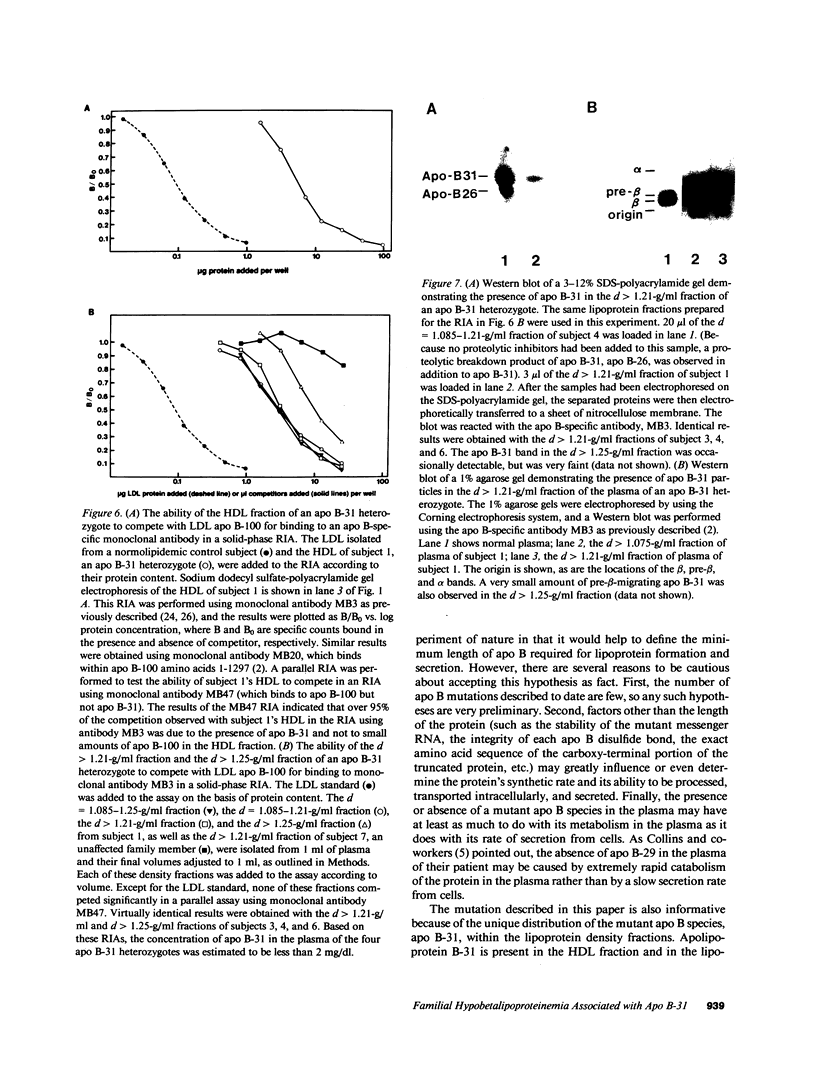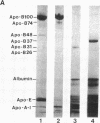Abstract
Apolipoprotein B-100 has a crucial structural role in the formation of VLDL and LDL. Familial hypobetalipoproteinemia, a syndrome in which the concentration of LDL cholesterol in plasma is abnormally low, can be caused by mutations in the apo B gene that prevent the translation of a full-length apo B-100 molecule. Prior studies have revealed that truncated species of apo B [e.g., apo B-37 (1728 amino acids), apo B-46 (2057 amino acids)] can occasionally be identified in the plasma of subjects with familial hypobetalipoproteinemia; in each of these cases, the truncated apo B species has been a prominent protein component of VLDL. In this report, we describe a kindred with hypobetalipoproteinemia in which the plasma of four affected heterozygotes contained a unique truncated apo B species, apo B-31. Apolipoprotein B-31 is caused by the deletion of a single nucleotide in the apo B gene, and it is predicted to contain 1425 amino acids. Apolipoprotein B-31 is the shortest of the mutant apo B species to be identified in the plasma of a subject with hypobetalipoproteinemia. In contrast to longer truncated apo B species, apo B-31 was undetectable in the VLDL and the LDL; however, it was present in the HDL fraction and the lipoprotein-deficient fraction of plasma. The density distribution of apo B-31 in the plasma suggests the possibility that the amino-terminal 1425 amino acids of apo B-100 are sufficient to permit the formation and secretion of small, dense lipoproteins but are inadequate to support the formation of the more lipid-rich VLDL and LDL particles.
Full text
PDF









Images in this article
Selected References
These references are in PubMed. This may not be the complete list of references from this article.
- Andersen G. E., Brokhattingen K., Lous P. Familial hypobetalipoproteinaemia in 9 children diagnosed as the result of cord blood screening for hypolipoproteinaemia in 10 000 Danish newborns. Arch Dis Child. 1979 Sep;54(9):691–694. doi: 10.1136/adc.54.9.691. [DOI] [PMC free article] [PubMed] [Google Scholar]
- Berger G. M., Brown G., Henderson H. E., Bonnici F. Apolipoprotein B detected in the plasma of a patient with homozygous hypobetalipoproteinaemia: implications for aetiology. J Med Genet. 1983 Jun;20(3):189–195. doi: 10.1136/jmg.20.3.189. [DOI] [PMC free article] [PubMed] [Google Scholar]
- Blanche P. J., Gong E. L., Forte T. M., Nichols A. V. Characterization of human high-density lipoproteins by gradient gel electrophoresis. Biochim Biophys Acta. 1981 Sep 24;665(3):408–419. doi: 10.1016/0005-2760(81)90253-8. [DOI] [PubMed] [Google Scholar]
- Chen S. H., Yang C. Y., Chen P. F., Setzer D., Tanimura M., Li W. H., Gotto A. M., Jr, Chan L. The complete cDNA and amino acid sequence of human apolipoprotein B-100. J Biol Chem. 1986 Oct 5;261(28):12918–12921. [PubMed] [Google Scholar]
- Cladaras C., Hadzopoulou-Cladaras M., Nolte R. T., Atkinson D., Zannis V. I. The complete sequence and structural analysis of human apolipoprotein B-100: relationship between apoB-100 and apoB-48 forms. EMBO J. 1986 Dec 20;5(13):3495–3507. doi: 10.1002/j.1460-2075.1986.tb04675.x. [DOI] [PMC free article] [PubMed] [Google Scholar]
- Collins D. R., Knott T. J., Pease R. J., Powell L. M., Wallis S. C., Robertson S., Pullinger C. R., Milne R. W., Marcel Y. L., Humphries S. E. Truncated variants of apolipoprotein B cause hypobetalipoproteinaemia. Nucleic Acids Res. 1988 Sep 12;16(17):8361–8375. doi: 10.1093/nar/16.17.8361. [DOI] [PMC free article] [PubMed] [Google Scholar]
- Cottrill C., Glueck C. J., Leuba V., Millett F., Puppione D., Brown W. V. Familial homozygous hypobetalipoproteinemia. Metabolism. 1974 Aug;23(8):779–791. doi: 10.1016/0026-0495(74)90010-9. [DOI] [PubMed] [Google Scholar]
- Curtiss L. K., Edgington T. S. Immunochemical heterogeneity of human plasma apolipoprotein B. I. Apolipoprotein B binding of mouse hybridoma antibodies. J Biol Chem. 1982 Dec 25;257(24):15213–15221. [PubMed] [Google Scholar]
- Curtiss L. K., Edgington T. S. Immunochemical heterogeneity of human plasma high density lipoproteins. Identification with apolipoprotein A-I- and A-II-specific monoclonal antibodies. J Biol Chem. 1985 Mar 10;260(5):2982–2993. [PubMed] [Google Scholar]
- Gavish D., Brinton E. A., Breslow J. L. Heritable allele-specific differences in amounts of apoB and low-density lipoproteins in plasma. Science. 1989 Apr 7;244(4900):72–76. doi: 10.1126/science.2565046. [DOI] [PubMed] [Google Scholar]
- Gibson J. C., Rubinstein A., Bukberg P. R., Brown W. V. Apolipoprotein E-enriched lipoprotein subclasses in normolipidemic subjects. J Lipid Res. 1983 Jul;24(7):886–898. [PubMed] [Google Scholar]
- Glueck C. J., Gartside P. S., Mellies M. J., Steiner P. M. Familial hypobeta-lipoproteinemia: studies in 13 kindreds. Trans Assoc Am Physicians. 1977;90:184–203. [PubMed] [Google Scholar]
- Hogle D. M., Smith R. S., Curtiss L. K. Quantitation of plasma apolipoprotein A-I using two monoclonal antibodies in an enzyme-linked immunosorbent assay. J Lipid Res. 1988 Sep;29(9):1221–1229. [PubMed] [Google Scholar]
- Huang L. S., Ripps M. E., Korman S. H., Deckelbaum R. J., Breslow J. L. Hypobetalipoproteinemia due to an apolipoprotein B gene exon 21 deletion derived by Alu-Alu recombination. J Biol Chem. 1989 Jul 5;264(19):11394–11400. [PubMed] [Google Scholar]
- Kahn J. A., Glueck C. J. Familial hypobetalipoproteinemia. Absence of atherosclerosis in a postmortem study. JAMA. 1978 Jul 7;240(1):47–48. doi: 10.1001/jama.240.1.47. [DOI] [PubMed] [Google Scholar]
- Kane J. P., Hardman D. A., Paulus H. E. Heterogeneity of apolipoprotein B: isolation of a new species from human chylomicrons. Proc Natl Acad Sci U S A. 1980 May;77(5):2465–2469. doi: 10.1073/pnas.77.5.2465. [DOI] [PMC free article] [PubMed] [Google Scholar]
- Knott T. J., Pease R. J., Powell L. M., Wallis S. C., Rall S. C., Jr, Innerarity T. L., Blackhart B., Taylor W. H., Marcel Y., Milne R. Complete protein sequence and identification of structural domains of human apolipoprotein B. Nature. 1986 Oct 23;323(6090):734–738. doi: 10.1038/323734a0. [DOI] [PubMed] [Google Scholar]
- Krul E. S., Kinoshita M., Talmud P., Humphries S. E., Turner S., Goldberg A. C., Cook K., Boerwinkle E., Schonfeld G. Two distinct truncated apolipoprotein B species in a kindred with hypobetalipoproteinemia. Arteriosclerosis. 1989 Nov-Dec;9(6):856–868. doi: 10.1161/01.atv.9.6.856. [DOI] [PubMed] [Google Scholar]
- LOWRY O. H., ROSEBROUGH N. J., FARR A. L., RANDALL R. J. Protein measurement with the Folin phenol reagent. J Biol Chem. 1951 Nov;193(1):265–275. [PubMed] [Google Scholar]
- Laskarzewski P. M., Khoury P., Morrison J. A., Kelly K., Mellies M. J., Glueck C. J. Prevalence of familial hyper- and hypolipoproteinemias: the Princeton School District Family Study. Metabolism. 1982 Jun;31(6):558–577. doi: 10.1016/0026-0495(82)90095-6. [DOI] [PubMed] [Google Scholar]
- Law S. W., Grant S. M., Higuchi K., Hospattankar A., Lackner K., Lee N., Brewer H. B., Jr Human liver apolipoprotein B-100 cDNA: complete nucleic acid and derived amino acid sequence. Proc Natl Acad Sci U S A. 1986 Nov;83(21):8142–8146. doi: 10.1073/pnas.83.21.8142. [DOI] [PMC free article] [PubMed] [Google Scholar]
- Leppert M., Breslow J. L., Wu L., Hasstedt S., O'Connell P., Lathrop M., Williams R. R., White R., Lalouel J. M. Inference of a molecular defect of apolipoprotein B in hypobetalipoproteinemia by linkage analysis in a large kindred. J Clin Invest. 1988 Sep;82(3):847–851. doi: 10.1172/JCI113688. [DOI] [PMC free article] [PubMed] [Google Scholar]
- Ludwig E. H., Blackhart B. D., Pierotti V. R., Caiati L., Fortier C., Knott T., Scott J., Mahley R. W., Levy-Wilson B., McCarthy B. J. DNA sequence of the human apolipoprotein B gene. DNA. 1987 Aug;6(4):363–372. doi: 10.1089/dna.1987.6.363. [DOI] [PubMed] [Google Scholar]
- Malloy M. J., Kane J. P. Hypolipidemia. Med Clin North Am. 1982 Mar;66(2):469–484. doi: 10.1016/s0025-7125(16)31431-6. [DOI] [PubMed] [Google Scholar]
- Milne R. W., Theolis R., Jr, Verdery R. B., Marcel Y. L. Characterization of monoclonal antibodies against human low density lipoprotein. Arteriosclerosis. 1983 Jan-Feb;3(1):23–30. doi: 10.1161/01.atv.3.1.23. [DOI] [PubMed] [Google Scholar]
- Pease R. J., Milne R. W., Jessup W. K., Law A., Provost P., Fruchart J. C., Dean R. T., Marcel Y. L., Scott J. Use of bacterial expression cloning to localize the epitopes for a series of monoclonal antibodies against apolipoprotein B100. J Biol Chem. 1990 Jan 5;265(1):553–568. [PubMed] [Google Scholar]
- Ross R. S., Gregg R. E., Law S. W., Monge J. C., Grant S. M., Higuchi K., Triche T. J., Jefferson J., Brewer H. B., Jr Homozygous hypobetalipoproteinemia: a disease distinct from abetalipoproproteinemia at the molecular level. J Clin Invest. 1988 Feb;81(2):590–595. doi: 10.1172/JCI113357. [DOI] [PMC free article] [PubMed] [Google Scholar]
- Saiki R. K., Gelfand D. H., Stoffel S., Scharf S. J., Higuchi R., Horn G. T., Mullis K. B., Erlich H. A. Primer-directed enzymatic amplification of DNA with a thermostable DNA polymerase. Science. 1988 Jan 29;239(4839):487–491. doi: 10.1126/science.2448875. [DOI] [PubMed] [Google Scholar]
- Sanger F., Nicklen S., Coulson A. R. DNA sequencing with chain-terminating inhibitors. Proc Natl Acad Sci U S A. 1977 Dec;74(12):5463–5467. doi: 10.1073/pnas.74.12.5463. [DOI] [PMC free article] [PubMed] [Google Scholar]
- Steinberg D., Grundy S. M., Mok H. Y., Turner J. D., Weinstein D. B., Brown W. V., Albers J. J. Metabolic studies in an unusual case of asymptomatic familial hypobetalipoproteinemia with hypolphalipoproteinemia and fasting chylomicronemia. J Clin Invest. 1979 Jul;64(1):292–301. doi: 10.1172/JCI109451. [DOI] [PMC free article] [PubMed] [Google Scholar]
- Yang C. Y., Chen S. H., Gianturco S. H., Bradley W. A., Sparrow J. T., Tanimura M., Li W. H., Sparrow D. A., DeLoof H., Rosseneu M. Sequence, structure, receptor-binding domains and internal repeats of human apolipoprotein B-100. Nature. 1986 Oct 23;323(6090):738–742. doi: 10.1038/323738a0. [DOI] [PubMed] [Google Scholar]
- Yang C. Y., Gu Z. W., Weng S. A., Kim T. W., Chen S. H., Pownall H. J., Sharp P. M., Liu S. W., Li W. H., Gotto A. M., Jr Structure of apolipoprotein B-100 of human low density lipoproteins. Arteriosclerosis. 1989 Jan-Feb;9(1):96–108. doi: 10.1161/01.atv.9.1.96. [DOI] [PubMed] [Google Scholar]
- Young S. G., Bertics S. J., Curtiss L. K., Casal D. C., Witztum J. L. Monoclonal antibody MB19 detects genetic polymorphism in human apolipoprotein B. Proc Natl Acad Sci U S A. 1986 Feb;83(4):1101–1105. doi: 10.1073/pnas.83.4.1101. [DOI] [PMC free article] [PubMed] [Google Scholar]
- Young S. G., Bertics S. J., Curtiss L. K., Dubois B. W., Witztum J. L. Genetic analysis of a kindred with familial hypobetalipoproteinemia. Evidence for two separate gene defects: one associated with an abnormal apolipoprotein B species, apolipoprotein B-37; and a second associated with low plasma concentrations of apolipoprotein B-100. J Clin Invest. 1987 Jun;79(6):1842–1851. doi: 10.1172/JCI113026. [DOI] [PMC free article] [PubMed] [Google Scholar]
- Young S. G., Bertics S. J., Curtiss L. K., Witztum J. L. Characterization of an abnormal species of apolipoprotein B, apolipoprotein B-37, associated with familial hypobetalipoproteinemia. J Clin Invest. 1987 Jun;79(6):1831–1841. doi: 10.1172/JCI113025. [DOI] [PMC free article] [PubMed] [Google Scholar]
- Young S. G., Bertics S. J., Scott T. M., Dubois B. W., Curtiss L. K., Witztum J. L. Parallel expression of the MB19 genetic polymorphism in apoprotein B-100 and apoprotein B-48. Evidence that both apoproteins are products of the same gene. J Biol Chem. 1986 Mar 5;261(7):2995–2998. [PubMed] [Google Scholar]
- Young S. G., Hubl S. T., Chappell D. A., Smith R. S., Claiborne F., Snyder S. M., Terdiman J. F. Familial hypobetalipoproteinemia associated with a mutant species of apolipoprotein B (B-46). N Engl J Med. 1989 Jun 15;320(24):1604–1610. doi: 10.1056/NEJM198906153202407. [DOI] [PubMed] [Google Scholar]
- Young S. G., Northey S. T., McCarthy B. J. Low plasma cholesterol levels caused by a short deletion in the apolipoprotein B gene. Science. 1988 Jul 29;241(4865):591–593. doi: 10.1126/science.3399894. [DOI] [PubMed] [Google Scholar]
- Young S. G., Peralta F. P., Dubois B. W., Curtiss L. K., Boyles J. K., Witztum J. L. Lipoprotein B37, a naturally occurring lipoprotein containing the amino-terminal portion of apolipoprotein B100, does not bind to the apolipoprotein B,E (low density lipoprotein) receptor. J Biol Chem. 1987 Dec 5;262(34):16604–16611. [PubMed] [Google Scholar]
- Young S. G., Smith R. S., Hogle D. M., Curtiss L. K., Witztum J. L. Two new monoclonal antibody-based enzyme-linked assays of apolipoprotein B. Clin Chem. 1986 Aug;32(8):1484–1490. [PubMed] [Google Scholar]
- Young S. G., Witztum J. L., Casal D. C., Curtiss L. K., Bernstein S. Conservation of the low density lipoprotein receptor-binding domain of apoprotein B. Demonstration by a new monoclonal antibody, MB47. Arteriosclerosis. 1986 Mar-Apr;6(2):178–188. doi: 10.1161/01.atv.6.2.178. [DOI] [PubMed] [Google Scholar]










